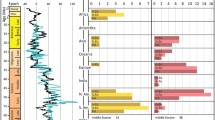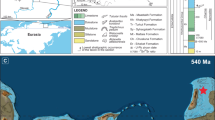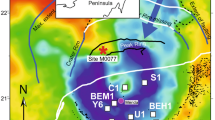Abstract
The transition between the Proterozoic and Phanerozoic eons, beginning 542 million years (Myr) ago, is distinguished by the diversification of multicellular animals and by their acquisition of mineralized skeletons during the Cambrian period1. Considerable progress has been made in documenting and more precisely correlating biotic patterns in the Neoproterozoic–Cambrian fossil record with geochemical and physical environmental perturbations2,3,4,5, but the mechanisms responsible for those perturbations remain uncertain1,2. Here we use new stratigraphic and geochemical data to show that early Palaeozoic marine sediments deposited approximately 540–480 Myr ago record both an expansion in the area of shallow epicontinental seas and anomalous patterns of chemical sedimentation that are indicative of increased oceanic alkalinity and enhanced chemical weathering of continental crust. These geochemical conditions were caused by a protracted period of widespread continental denudation during the Neoproterozoic followed by extensive physical reworking of soil, regolith and basement rock during the first continental-scale marine transgression of the Phanerozoic. The resultant globally occurring stratigraphic surface, which in most regions separates continental crystalline basement rock from much younger Cambrian shallow marine sedimentary deposits, is known as the Great Unconformity6. Although Darwin and others have interpreted this widespread hiatus in sedimentation on the continents as a failure of the geologic record, this palaeogeomorphic surface represents a unique physical environmental boundary condition that affected seawater chemistry during a time of profound expansion of shallow marine habitats. Thus, the formation of the Great Unconformity may have been an environmental trigger for the evolution of biomineralization and the ‘Cambrian explosion’ of ecologic and taxonomic diversity following the Neoproterozoic emergence of animals.
This is a preview of subscription content, access via your institution
Access options
Subscribe to this journal
Receive 51 print issues and online access
$199.00 per year
only $3.90 per issue
Buy this article
- Purchase on Springer Link
- Instant access to full article PDF
Prices may be subject to local taxes which are calculated during checkout




Similar content being viewed by others
References
Marshall, C. R. Explaining the Cambrian “Explosion” of animals. Annu. Rev. Earth Planet. Sci. 34, 355–384 (2006)
Maloof, A. C. et al. The earliest Cambrian record of animals and ocean geochemical change. Geol. Soc. Am. Bull. 122, 1731–1774 (2010)
Canfield, D. E., Poulton, S. W. & Narbonne, G. M. Late-Neoproterozoic deep-ocean oxygenation and the rise of animal life. Science 315, 92–95 (2007)
Dahl, T. W. et al. Devonian rise in atmospheric oxygen correlated to radiations of terrestrial plants and large predatory fish. Proc. Natl Acad. Sci. USA 107, 17911–17915 (2010)
Gill, B. C. et al. Geochemical evidence for widespread euxinia in the later Cambrian ocean. Nature 469, 80–83 (2011)
Yochelson, E. L. The Lipalian interval: a forgotten, novel concept in the geologic column. Earth Sci. Hist. 25, 251–269 (2006)
Avigad, D. et al. Mass-production of Cambro-Ordovician quartz-rich sandstone as a consequence of chemical weathering of Pan-African terranes: environmental implications. Earth Planet. Sci. Lett. 240, 818–826 (2005)
Laird, M. G. in Geological Evolution of Antarctica (eds Thomson, M. R. A., Crame, J. A. & Thomson, J. W. ) 177–186 (Cambridge Univ. Press, 1991)
Brasier, M. D. The Lower Cambrian transgression and glauconite-phosphate facies in western Europe. J. Geol. Soc. Lond. 137, 695–703 (1980)
Sears, J. W. & Price, R. A. Tightening the Siberian connection to western Laurentia. Geol. Soc. Am. Bull. 115, 943–953 (2003)
Sloss, L. L. Sequences in the cratonic interior of North America. Geol. Soc. Am. Bull. 74, 93–114 (1963)
Meyers, S. R. & Peters, S. E. A 56 million year rhythm in North American sedimentation during the Phanerozoic. Earth Planet. Sci. Lett. 303, 174–180 (2011)
Cross, T. A. & Lessenger, M. A. in Innovative Applications of Petroleum Technology in the Rocky Mountain Region (eds Coalson, E. B., Osmond, J. C. & Williams, E. T. ) 183–203 (Rocky Mountain Association of Geologists, Denver, 1997)
Mortatti, J. & Probst, J. Silicate rock weathering and atmospheric/soil CO2 uptake in the Amazon basin estimated from river water geochemistry: seasonal and spatial variations. Chem. Geol. 197, 177–196 (2003)
Millot, R. Gaillardet, J. Dupré, B. & Allegre, C. J. The global control of silicate weathering rates and the coupling with physical erosion: new insights from rivers of the Canadian Shield. Earth Planet. Sci. Lett. 196, 83–98 (2002)
Robison, R. A. in Guidebook to the Geology of East Central Nevada (eds Boettcher, J. W. Jr & Sloan, W. W. ) 43–52 (Intermountain Association of Petroleum Geologists, Salt Lake City, 1960)
Ronov, A. B., Khain, V. E., Balukhovsky, A. N. & Seslavinsky, K. B. Quantitative analysis of Phanerozoic sedimentation. Sedim. Geol. 25, 311–325 (1980)
Walker, L. J., Wilkinson, B. H. & Ivany, L. C. Continental drift and Phanerozoic carbonate accumulation in shallow-shelf and deep-marine settings. J. Geol. 110, 75–87 (2002)
Ginsburg, R. N. Actualistic depositional models for the Great American Bank (Cambro-Ordovician). In Eleventh International Congress on Sedimentology, Abstracts of Papers 114 (International Association of Sedimentologists/McMaster University, 1982)
Ridgwell, A. J., Kennedy, M. J. & Caldeira, K. Carbonate deposition, climate stability, and Neoproterozoic ice ages. Science 302, 859–862 (2003)
Gaines, R. R. et al. Mechanism for Burgess Shale-type preservation. Proc. Natl Acad. Sci. USA http://dx.doi.org/10.1073/pnas.1111784109 (published online, 5 March 2012)
Coleman, M. L. Geochemistry of diagenetic non-silicate minerals: kinetic considerations. Phil. Trans. R. Soc. Lond. A 315, 39–56 (1985)
Elrick, M. & Snider, A. S. Deep-water stratigraphic cyclicity and carbonate mud mound development in the Middle Cambrian Marjum Formation, House Range, Utah, U.S.A. Sedimentology 49, 1021–1047 (2002)
Odin, G. S. & Matter, A. De glauconiarum origine. Sedimentology 28, 611–641 (1981)
Chafetz, H. S. & Reid, A. Syndepositional shallow-water precipitation of glauconite minerals. Sedim. Geol. 136, 29–42 (2000)
Keto, L. S. & Jacobson, S. B. Nd isotopic variations of Phanerozoic palaeoceans. Earth Planet. Sci. Lett. 90, 395–410 (1988)
Lowenstein, T. K. et al. Oscillations in Phanerozoic seawater chemistry: evidence from fluid inclusions. Science 294, 1086–1088 (2001)
Brennan, S. T., Lowenstein, T. K. & Horita, J. Seawater chemistry and the advent of biocalcification. Geology 32, 473–476 (2004)
Petrychenko, O. Y., Peryt, T. M. & Chechei, E. I. Early Cambrian seawater chemistry from fluid inclusions in halite from Siberian evaporites. Chem. Geol. 219, 149–161 (2005)
Erwin, D. H. et al. The Cambrian conundrum: early divergence and later ecological success in the early history of animals. Science 334, 1091–1097 (2011)
Acknowledgements
We thank D. Canfield, P. Cohen, W. Fischer, S. Finnegan, N. Heim, A. Carroll and R. Dott for discussion, and N. Butterfield, M. Foote, E. Hammarlund, P. Myrow, B. Wilkinson, R. Wood, S. Holland for feedback on ideas. Fieldwork and analysis was aided by P. Burke, J. B. Caron, L. Curtin, F. Dwan, Z. Feng, P. Fenton, L. Finley-Blasi, X. Hou, J. Lackey, C. Qi, J. Peng, J. Tian, J. Vorhies, Y. Yang, X. Zhang and Y. Zhao. Work was supported by NSF EAR-0819931 (to S.E.P.) and EAR-1046233 and DUE-0942447 (to R.R.G.).
Author information
Authors and Affiliations
Contributions
S.E.P. contributed Macrostrat-derived data, R.R.G. contributed sample-derived data. Both authors contributed to the development of ideas and writing.
Corresponding author
Ethics declarations
Competing interests
The authors declare no competing financial interests.
Additional information
Data for aspects of this analysis derive from Macrostrat (http://macrostrat.org).
Supplementary information
Supplementary Information
This file contains Supplementary Figures 1-8, Supplementary Tables 1-3 and additional references. (PDF 9479 kb)
Rights and permissions
About this article
Cite this article
Peters, S., Gaines, R. Formation of the ‘Great Unconformity’ as a trigger for the Cambrian explosion. Nature 484, 363–366 (2012). https://doi.org/10.1038/nature10969
Received:
Accepted:
Published:
Issue Date:
DOI: https://doi.org/10.1038/nature10969
This article is cited by
-
Glauconite facies developed sequentially in the Abu Tartur Plateau (Egypt) during the Late Cretaceous
Euro-Mediterranean Journal for Environmental Integration (2024)
-
Secular craton evolution due to cyclic deformation of underlying dense mantle lithosphere
Nature Geoscience (2023)
-
Reappraisal of the Neoproterozoic to middle Paleozoic fossils of North Korea and its tectonic implication
Geosciences Journal (2023)
-
Diversified calcimicrobes in dendrolites of the Zhangxia Formation, Miaolingian Series (Middle Cambrian) of the North China craton
Journal of Palaeogeography (2021)
-
Current understanding on the Cambrian Explosion: questions and answers
PalZ (2021)
Comments
By submitting a comment you agree to abide by our Terms and Community Guidelines. If you find something abusive or that does not comply with our terms or guidelines please flag it as inappropriate.



